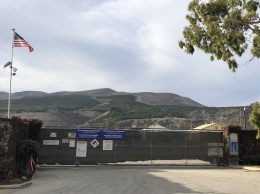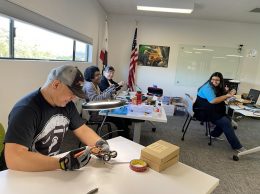Tri-Counties enter Stage 2 of reopening
IN THIS ARTICLE
- Health Care & Life Science Topic
- pacbiztimes Author
By pacbiztimes Thursday, May 21st, 2020
Story updated at 10:30 a.m. May 22:
San Luis Obispo, Santa Barbara and Ventura counties officially got the state’s approval to move into Stage 2 of reopening on May 20.
Tens of thousands of businesses and 1.4 million residents are roughly on the same path to ending the lockdown orders imposed in early March due to the COVID-19 pandemic. In order to move forward with reopening and economic recovery, counties have to meet several criteria:
• Stable hospitalizations of COVID-19 individuals on a seven-day average of daily percent change of less than 5 percent or no more than 20 COVID-19 hospitalizations on any single day in the past 14 days.
• Less than 25 new cases per 100,000 residents in the past 14 days or less than 8 percent testing positive in the county.
San Luis Obispo County meets the less than 25 new cases per 100,000 residents standard, while both Santa Barbara County and Ventura County meet the second part of the criteria with less than 8 percent testing positive in either county.
Ventura County CEO Mike Powers said being allowed to move further into Stage 2 is a welcome relief.
He said the county has been working with businesses to help restore commerce in the area while also keeping everyone safe and he praised business leaders.
“They’ve been so helpful,” Powers said. “They want to comply, not just with the letter but with the spirit, because they want to protect their employees and their community as a whole.”
So far, more than 3,200 businesses have already registered to reopen.
Businesses don’t need an inspection to reopen, but a business ambassador from the county will come by a few weeks after the business has reopened to see how the location is doing and give any suggestions, if necessary.
“We’re moving forward,” Powers said. “When these businesses reopen, we want them to stay open.”
Santa Barbara County almost didn’t make the cut.
An outbreak in the federal prison in Lompoc has dramatically shot up the county’s confirmed case count, accounting for almost two-thirds of the county’s total cases, but the county’s health officials don’t have any authority over the prison or its health situation.
Because the prison is outside of the county’s jurisdiction, the county asked the state to not count the prison against its numbers, and on May 19 the state agreed.
Once the state approves each county’s reopening plans, the counties can move farther into Stage 2, which lets schools and childcare facilities reopen with some modifications.
The state floated the possibility of the next school year starting earlier to address learning gaps from the interruption caused by COVID-19. Dine-in restaurants and shopping centers would also come back online, but places like brewpubs, breweries, bars and wineries are still encouraged to stay closed unless they can offer sit-down, dine-in meals. The state encouraged food and beverage establishments to continue offering takeout and delivery “whenever possible.”
In order to reopen, businesses must complete a self-evaluation form. Someone within the business must create a plan for how the business is going to protect its customers and staff from getting or spreading the coronavirus.
In SLO County, that means performing a detailed risk assessment, creating specific plans and procedures to reduce the risk of spreading coronavirus and training employees in ways they can reduce risk.
SLO County businesses don’t have to turn in those forms to reopen, but they do have to make those forms available.
Santa Barbara County has industry-specific checklists businesses can refer to, but didn’t have self-evaluation forms available at press time May 20, and while more than 1,000 businesses have already registered to reopen in Ventura County, its reopening website couldn’t be accessed for several hours before presstime.
City governments are also taking steps to make it easier for businesses to operate once they reopen.
The cities of Ventura and Santa Barbara are looking at closing off parts of central streets to allow restaurants and other businesses to expand beyond limited indoor space onto their patios and sidewalks.
Santa Barbara will allow expanded outdoor dining, citywide, and the closure of State Street from the 500 block (Haley Street) to the 1200 block (Sola Street).
Jason Harris, the city’s economic development director, said the city is also looking at closing the 400 block. The closures would be on a semi-permanent basis; the streets wouldn’t be closed during one period of the day and opened during another.
“We want to encourage the local population to have a closed street experience, to feel comfortable going out again,” Harris said.
Having more room for people to spread out will help both restaurants and retail stores. Harris said the city is also looking at closing other streets, depending on how the closure of State Street goes.
Similarly, in Ventura, Main Street would be the first one to close partially to allow for more business.
During the Ventura City Council meeting May 19, it also discussed other ways to support local businesses, including speeding up the regulatory and permitting process.
“I think it is imperative that our local business community is supported during this difficult time,” Ventura Mayor Matt LaVere wrote in a Facebook post addressing the changes and likely steps going forward. “We must think outside of the box and pursue bold strategies to boost the recovery efforts of business throughout the city.”
Reopening more businesses is a balancing act, Santa Barbara County First District Supervisor Das Williams said.
While the county is being careful to limit the spread of COVID-19, health officials are also mindful of the issues that come from people not being able to work.
“Poverty is a health danger,” Williams said. “Mental health crises are a health danger.”
Williams said at least 25,000 people in the county are out of work, and it’s disproportionally people who earn lower incomes.
“The long-term health of residents of Santa Barbara County is dependent on people being able to go back to work.”
• Contact Amber Hair at [email protected].
Related Articles
 Friday, October 14th, 2022
Friday, October 14th, 2022











